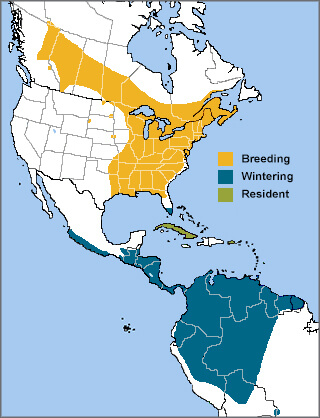
Broad-winged Hawk range map by ABC
The Broad-winged Hawk is a small and secretive hawk of eastern forests, about the size of an American Crow. Unlike the slender, long-legged Cooper's Hawk, which shares parts of its range, this hawk is a member of the Buteo genus, a group of stocky, long-winged and short-tailed hawks that includes the more widespread Red-tailed Hawk. An adult Broad-winged Hawk is brown above with a barred rufous chest. In flight, its white underwings are edged in black and its spread tail shows a conspicuous white band. An all-dark form occurs, but is rare.
This smallest of eastern Buteos tends to remain inconspicuous while nesting, but as that season draws to a close, the Broad-winged Hawk becomes part of a yearly spectacle that fascinates birders throughout the Americas.
Incredible Kettles
Like the Swainson's Hawk of western North America, the Broad-winged Hawk is a champion long-distance migrant. Both of these buteos head south each fall in large groups, known as "kettles," that range from a few dozen to hundreds of thousands of individuals.
Migrating Broad-wings are reluctant to fly across large bodies of water; instead, they prefer to follow a land-based route that takes advantage of rising thermals and mountain updrafts. This flight strategy allows Broad-winged Hawks to travel long distances with minimal effort – especially important since this raptor does not build up a pre-migratory layer of fat to power its journey, as do migrating songbirds such as the Blackpoll Warbler and Wood Thrush.
Huge numbers of Broad-winged Hawks stream past count sites such as Hawk Mountain, Pennsylvania, and Cape May, New Jersey, on their way south to Mexico and Central and South America. Their numbers concentrate even further as they travel down the gradually narrowing isthmus of Mexico and Central America. Staggering numbers of Broad-winged and Swainson's Hawks, along with Swallow-tailed and Mississippi Kites, Osprey, Turkey Vultures, and many other waterbirds and songbirds, can be seen passing migratory "choke points" such as the famous River of Raptors in Veracruz, Mexico.
The Caribbean Connection
Six subspecies of Broad-winged Hawk are recognized, five of which are resident (nonmigratory) on the islands of the West Indies, including Cuba and Puerto Rico. The Puerto Rican subspecies of Broad-winged Hawk is considered Endangered, with a population of only about 100 birds.
The nominate subspecies of Broad-winged Hawk is the migratory group. These birds breed in dense forests of the eastern and central U.S. and Canada, and migrate to tropical highlands from southern Mexico to South America each winter. Some Broad-wings remain in Florida for the winter. Although most birds in this subspecies breed east of the Mississippi River, some westward expansion in their range has been observed since the 1970s.
The Broad-winged Hawk's call is a high, thin-sounding whistle that sounds like "peweee," often given in flight. This distinctive call is often heard before the hawk itself is spotted.
Listen here:
(Audio: Ross Gallardy, XC353341. Accessible at www.xeno-canto.org/353341)
Mid-migration Munchies
Like many predatory bird species ranging from the American Kestrel to Great Crested Flycatcher, the Broad-winged Hawk is a "sit-and-wait" hunter, quietly scanning for prey from a perch in the forest understory or edge, then pouncing on it. Most of its diet consists of frogs, lizards, bird nestlings, and small mammals.

Migrating Broad-winged Hawks by Greg Lavaty/texastargetbirds.com
Broad-winged Hawks will sometimes take dragonflies and butterflies in mid-air, particularly during migration, when these insects are also moving south in large numbers. During the breeding season, this hawk often caches captured prey near its nest for later consumption.
Sticks and Sprigs
Broad-winged Hawks form pair-bonds soon after arriving on their forest breeding grounds. Their courtship includes whistled calls and paired soaring and swooping displays. Once mated, this hawk settles down to nest within the forest canopy, where it can be difficult to detect.
Both male and female build a rather crude nest of sticks and tree sprigs, usually in the crotch of a deciduous tree. The nest is lined with bark chips, and fresh vegetation may be placed along the top of the structure. Nests are rarely re-used from year to year, although the pair may refurbish an old crow or squirrel nest.
The female Broad-wing lays two to four eggs and incubates them for roughly a month; her mate supplies food while she's on the nest. Once the chicks hatch, the parents care for them for another month. After fledging, the young Broad-wings stay close to their parents, which continue to supply them with food for up to eight more weeks.
Still Persecuted as Pests
Broad-winged Hawks were once commonly shot as pests. Although they are now protected in North America by laws such as the Migratory Bird Treaty Act, these hawks are often still persecuted during migration and on their wintering grounds.
Much of the Broad-winged Hawk's breeding habitat has been restored with the regrowth of eastern forests, although in many places certain forest management practices have led to a decline in the overall health of these forests. Habitat loss and fragmentation pose challenges to this hawk on its wintering grounds. The species also needs appropriate stopover habitat (relatively unbroken forest) in which to rest and feed during migration.
ABC is involved in a number of large-scale initiatives that conserve and recover habitat for the Broad-winged Hawk and other migratory bird species on vital breeding and wintering grounds. These include our BirdScapes approach to migratory bird conservation and our participation in Migratory Bird Joint Ventures.
Donate to support ABC's conservation mission!



















































